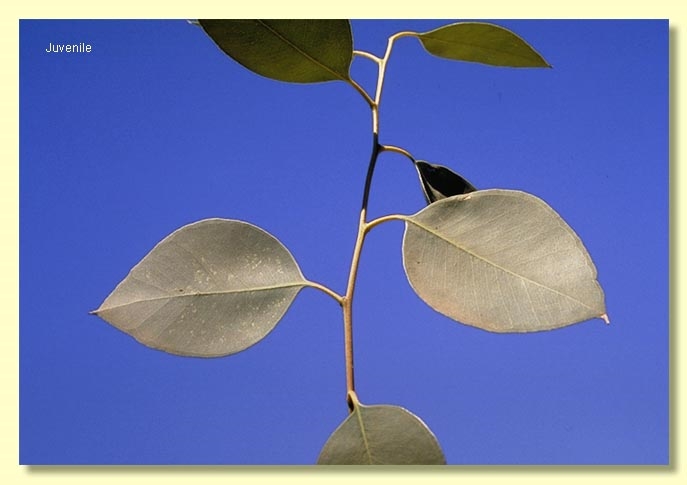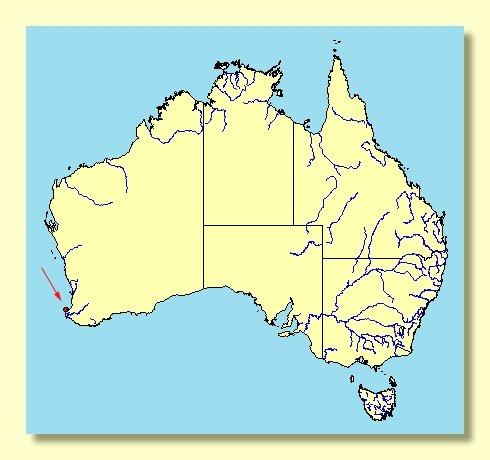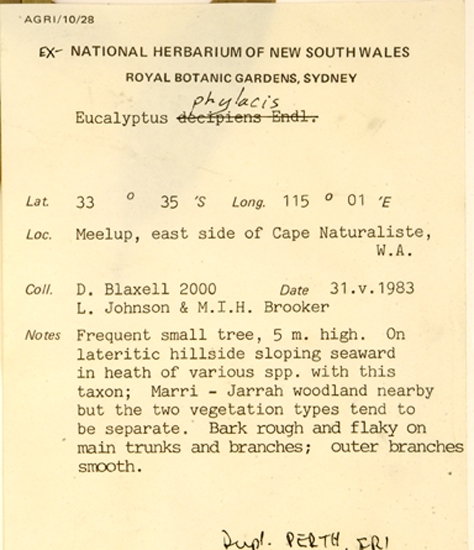Euclid - Online edition
Eucalyptus x phylacis
Eucalyptus | Symphyomyrtus | Bisectae | Destitutae
The x in the above binomial indicates hybrid status and is used here in accordance with Australian Plant Census https://biodiversity.org.au/nsl/services/apc accessed 19 April 2017.
D. Nicolle & M.E. French, in Nuytsia 22: 448 (2012), concluded that Eucalyptus x phylacis is a hybrid between Eucalyptus decipiens (of E. series Falcatae) and E. virginea (of E. series Curvipterae).
Bark rough to ca 5 cm diameter branches, hard and corky, not fibrous, forming multi-layered plates and strips, grey and brown.
Branchlets lacking oil glands in the pith.
Juvenile growth (coppice or field seedlings to 50 cm): juvenile leaves petiolate, alternate, orbicular to ovate, to 5 cm long and 4 cm wide, apex rounded, grey-blue.
Adult leaves alternate, petioles 1–2 cm long; blade lanceolate or falcate, 7.5–12.5 cm long, 1.3–2.5 cm wide, base tapering to petiole, margin entire, apex acute, concolorous, green, glossy, side-veins greater than 45° to midrib, reticulation dense to very dense, intramarginal vein close to or remote from margin, oil glands irregular, large, intersectional.
Inflorescence axillary unbranched, peduncles 0.7–1.5 cm long, buds 11, pedicellate (pedicels 0.2–0.4 cm long). Mature buds ovoid to diamond-shaped (0.7–0.9 cm long, 0.5–0.6 cm wide), scar present, operculum conical, stamens inflexed, anthers more or less cuboid, versatile, sub-basifixed, dehiscing by longitudinal slits, style long and straight, stigma blunt to rounded, locules 3 or 4, the placentae each with 4 vertical rows of ovules or with 2 complete rows and the outer rows consisting only of 1 or 2 ovules. Flowers creamy white.
Fruit very shortly pedicellate to sessile (pedicels 0–0.3 cm long), hemispherical, 0.5–0.6 cm long, 0.5–0.6 cm long, 0.8–0.9 cm wide, disc level, cracked radially, valves 3 or 4, strongly exserted.
Seeds not formed.
Flowering has been recorded in May and October.
A robust mallee endemic to Western Australia, known only from a single small stand in hills above Eagle Bay, near Meelup west of Busselton, south of Perth. The bark is rough and the adult leaves glossy green, with side-veins very numerous and regularly pinnate, and oil glands irregular and intersectional.
Brooker (2000) placed Eucalyptus phylacis in Eucalyptus subgenus Symphyomyrtus section Bisectae subsection Destitutae because buds have two opercula, ovules are in four rows, anthers are cuboid and versatile and branchlets lack oil glands in the pith. The cotyledons have never been seen. Brooker included E. phylacis in a distinctive small group of species all with more or less sessile buds in crowded stellate clusters in the leaf axils, crowded fruit and with leaves having numerous side veins, dense reticulation and intersectional oil glands. In this small group (known as series Falcatae subseries Decipientes ) Brooker listed five taxa, viz. E. decipiens, E. communalis and E. obesa and also E. balanites and E. phylacis, but see below.
Eucalyptus x phylacis has long been regarded as a hybrid involving E. decipiens and another species. The latest field investigation by Nicolle & French (2012) concluded that the single multi-stemmed and now fragmented lignotuberous plant of E. x phylacis is a hybrid between E. decipiens and E. virginea, both of which occur nearby. Fertile seed is not formed. [Of the other species in Brooker's subseries Decipientes E. x balanites is also now acknowledged to be a hybrid, see that species for details; plants of E. communalis are now regarded as intergrades or morphological intermediates between E. obesa and E. adesmophloia, see the latter for details].
Eucalyptus x phylacis differs from E. decipiens in having pedicellate, more diamond-shaped buds and broader fruit and having juvenile leaves on coppice growth that are ovate to orbicular with rounded tips, not emarginate. The bark of E. x phylacis is flaky-platey on the surface and corky beneath, not fibrous or hard as in E. decipiens. The buds of another related hybrid species, E. x balanites, are more rounded than E. x phylacis, fruit are larger and juvenile leaves elliptical.
The known plants of E. x phylacis stems, all of which occur in less than a quarter of a hectare, have been shown to be genetically identical using techniques of DNA analysis. The inference from this is that the population started from a single lignotuberous individual in the distant past and that individual has, with time and disturbance, fragmented into several mallee-form plants (see Rossetto, M. et al, 1999).
Eucalyptus x phylacis is listed as "Endangered" under the Australian Government Environment Protection and Biodiversity Conservation Act 1999 (EPBC Act). Further information may be found at this web address:
http://www.environment.gov.au/cgi-bin/sprat/public/sprat.pl















